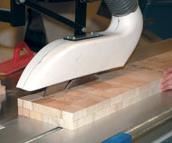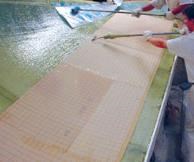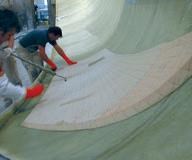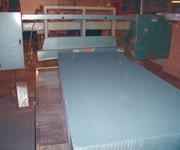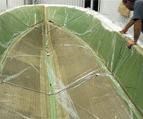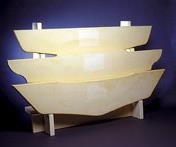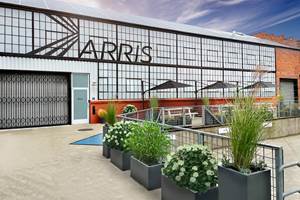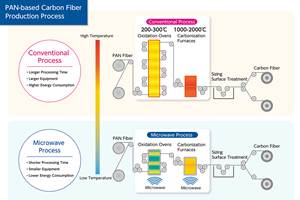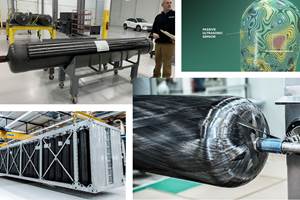Getting To The Core Of Composite Laminates
A wealth of low-cost core solutions are available for high-performance sandwich structures.
Although the largest market for core is still aerospace — where high-performance aluminum and aramid honeycomb cores are used in aircraft primary structure, as well as in interior panels and floors — honeycombs, foam and balsa wood play a significant role in structural parts for the marine, wind energy and transportation markets. Lightweight, low in density and available at relatively low cost, core materials provide the foundation for incredibly strong and stiff sandwich structures, when placed between skins made with reinforcing fibers and resin. Given the right combination of core, composite skins and adhesive, composite manufacturers can deliver cost-effective sandwich structures to customers in virtually any non-aerospace market where high stiffness and low weight are design priorities.
With the multitude of core types available, in variable densities and many types of surface finish, core selection begins with careful consideration of the manufacturing process and the desired performance of the overall laminate, says Alex Gutierrez, business development manager for the DIAB Group's (Laholm, Sweden) DeSoto, Texas operation. "It's a total engineered solution that must consider the core as well as the skins and the adhesion between them," he explains. "You need to analyze the demands on the overall structure to make your core decisions."
WHY A CORED SANDWICH?
Composite designers determined early on that sandwiching a low-density, lightweight core material between thin face sheets can dramatically increase a laminate's stiffness with little added weight. A sandwich structure is cost-effective because the relatively low-cost core replaces more expensive composite reinforcement material and can be cocured with the skins in one-shot processes like resin infusion. And the stiffer but lighter sandwich panel requires less supporting structure than a solid laminate.
In a sandwich panel, the core functions like the connecting web of an I-beam, separating the face skins at a constant distance, while the skins themselves function as the I-beam flanges (see illustration, p. 26). The sandwich panel's bending stiffness is proportional to the core thickness, in the same way an I-beam is stiffer as the distance between the flanges increases. Doubling the core thickness yields a panel six times stronger and 12 times stiffer, with very little weight increase, says Dr. Brent Strong of Brigham Young University (Provo, Utah, U.S.A.).
Core also helps distribute loads and stresses on the skins, which makes a cored sandwich an excellent design for absorbing impact stresses. While honeycomb has a higher strength-to-weight ratio, solid foam or balsa cores are in contact with 100 percent of the skin area, which spreads the impact over a larger area than honeycomb. A core's compression strength prevents the thin skins from wrinkling (buckling) failure, while its shear modulus keeps the skins from sliding independent of each other when subjected to bending loads. Equally important is the adhesive that bonds the core to the skins — it must be strong enough to withstand the constant compression/tension forces of dynamic loading, such as the forces on a boat hull. The coefficients of thermal expansion (CTE) of the core, the laminate material and the adhesive must be compatible to ensure that thermal cycling doesn't cause debonding.
With the explosion of closed molding methods over the last few years, new grooved core forms have been developed that can be used as the resin infusion media, without the need for special sacrificial resin flow media layers. Because laminates are processed and cured in a single shot, infusing thick monolithic laminates is risky because of the potential for high exotherm. Cores help reduce the thickness of the infused laminate, giving fabricators greater control over their processes. Plus, cored panels offer excellent heat insulation, sound abatement, fire proofing and vibration damping.
A number of nonwoven "bulker ply" core products are also available, like Lantor Composites' (Veenedaal, The Netherlands) Coremat product or nonwovens containing microspheres like those from spheretex America Inc. (Pointe Vedra Beach, Fla., U.S.A.). These very lightweight, core-like mats, although not covered in this article, can offer structural performance as well as improved cosmetics (by preventing print-through of woven fiber laminates), vibration and noise dampening, weight reduction and lower labor costs (because of ease of handling). Fabricators say they like the improved impact resistance and elongation as well as weight savings compared to traditional cores, depending on design, and they are certainly very viable alternatives to the core types discussed below.
FOAM CORES
Structural foam cores are manufactured from a number of thermoset and thermoplastic polymers including polyvinyl chloride (PVC), polyurethane (PU), polystyrene (PS), styrene acrylonitrile (SAN), polyetherimide (PEI) and polymethacrylimide (PMI). Foams (with the exception of polyurethanes) are produced by mixing liquid polymers and blowing agents, then pouring the mixture into metal molds and allowing a partial cure under high heat and pressure. The resulting rubbery mass, sometimes called an amoeba or an embryo, is demolded, then placed in a second mold and heated again (with hot water or steam) in an expansion chamber, which activates the blowing agent and controls the gas expansion pressure. The result is a roughly 4-ft by 8-ft by several-inch-thick block of foam, containing closed, gas-filled bubbles or cells. Foams can be manufactured in densities ranging from 2 lb/ft3 (30 kg/m3) up to 20 lb/ft3 (300 kg/m3) by varying the ratio of the polymer ingredients to blowing agents and adjusting gas pressure. Polyurethane foam, a thermoset that generates gas when an isocyanate is mixed with a polyol, is either made in batches ("bun casting") or a continuous foaming process.
Of the various structural foam core types, perhaps the most commonly used is PVC, which is actually a hybrid of PVC and polyurea. Two types of PVC foam are available. Crosslinked, or semi-rigid, foams are relatively stiff and strong, can perform at temperatures up to 120°C/250°F and are resistant to styrene, so they can be used with polyester and vinyl ester resins. Linear or ductile PVC foams, made with a different polymer formulation, are more elastic than crosslinked varieties and are widely used in marine applications, where they offer high deflection before failure and excellent impact resistance. While linear PVC is easier to heat-form around complex curves, the tradeoff is somewhat lower mechanical properties and reduced temperature resistance compared to the crosslinked version. Both offer good properties in fatigue resistance.
Because foams like PVC contain gas under pressure, outgassing can occur over time — that is, the gas escapes from the closed cells and migrates to voids or unbonded areas in the laminate. In some instances, outgassing has been blamed for delaminations and blistering in marine construction, especially in parts made at elevated cure temperatures with epoxy resin systems or finished in dark colors. But core experts contend the problem is caused primarily by improper laminating technique and poor skin-to-core bond. Most core manufacturers offer "stabilized" products that minimize the problem.
DIAB is the largest structural foam core manufacturer, with production facilities in Sweden, Italy and the U.S. It produces Divinycell and Klegecell, both semi-rigid, crosslinked PVC foams. Both are used extensively in the marine, transportation, wind and general industrial products markets, says Gutierrez. The company also produces a linear PVC foam, Divinycell HD, used mainly in military applications.
The toughened, high-density Divinycell HD was recently selected as the core material below the waterline for the Visby-class military corvette ship, built by Swedish marine fabricator Kockums for the Swedish Royal Navy. The 300-ft long minehunter/anti-submarine vessel is constructed entirely of resin-infused carbon fiber/vinyl ester cored composite panels for extreme light weight and stealth characteristics. Kockums' composites designers selected the Divinycell PVC product for its high elongation and impact resistance, to counteract the high-speed ship's slam loads encountered in rough seas as well as the forces of underwater mine explosions.
A specialist in resin infusion processing, DIAB offers a line of scored, grooved and perforated cores for use as infusion media. The channels in the core increase the core material permeability and enable infusion without the need for separate, sacrificial flow media. Gutierrez says that parts fabricators have embraced infusion in the last few years because it can produce consistent, higher quality parts more cost-effectively. DIAB maintains a staff of dedicated engineers who support the company's infusion products sales, by visiting customers and training the operators in the correct application of the products and processing methods.
DIAB is currently building a new production facility in Red Oak, Texas, U.S.A., that will double its foam core production in the Americas. The increased production is in direct response to the rapidly growing wind energy market, as well as continued demand in other sectors such as transportation and aerospace, says Gutierrez. A growth area for DIAB, as well as other core producers, is core kits, which are custom-cut cores made specifically to fit a customer's parts. Kitting enables the customer to build parts with virtually no wasted materials.
Alcan Airex AG (Sins, Switzerland), another major European-based foam core producer, has offered its Airex linear and crosslinked PVC foams to the marine, transportation, wind energy and industrial markets for over four decades. Airex R63, a linear PVC, is well-known for its ductility and impact resistance.
To complement its standard Airex C70, the company recently developed a new Airex C71 crosslinked PVC with a higher temperature resistance for processing up to 121°C/250°F, compatible with the heated molds and prepreg resin systems often employed by wind turbine blade manufacturers for faster part turnaround. It also is thermoformable for the more complex mold shapes of a blade (as compared to a flat panel).
Alcan Airex also offers Airex R82, a polyetherimide (PEI) thermoplastic foam product with a very high processing temperature — "well above" that of crosslinked PVC or SAN, says George Dohn, director of industrial products for Alcan Baltek Corp. Because of its dielectric properties and thermoformability, PEI foam is often specified for high-performance applications like radomes for military and commercial aircraft. It also can be used as an edge treatment for aluminum and aramid honeycomb cored panels in aerospace applications, says Dohn. PEI's excellent fire/smoke/toxicity properties exceed most worldwide standards for road and rail transportation systems and commercial aircraft interiors. This led to its selection for the floor panels, front end and skirts in the maglev high-speed train that serves the Shanghai, China airport.
A HOST OF OTHER FOAMS
Styrene acrylonitrile (SAN) foam core is a relatively new product introduced in the 1990s by Canadian firm ATC Chemicals Inc., recently acquired by SP Systems (Newport, Isle of Wight, U.K., a Gurit Composite Technologies company). The linear closed-cell thermoplastic SAN foam, trademarked as Core-Cell, combines good static mechanical properties with high elongation, resulting in impact toughness and fatigue resistance — in essence, delivering the best properties of both crosslinked and linear PVC. Core-Cell is very chemically stable, and resistant to the resin systems used in composite construction.
Core-Cell can be processed at temperatures up to 85°C/185°F, higher than linear PVC foams. An advantage of that heat resistance, says Jef Benkelman, technical support expert for SP Systems North America, is that SAN works well with epoxy prepreg systems that require heat cure. "Where some PVCs will outgas under the heat of prepreg cure and interfere with bonding, the SAN foam chemistry allows the core to bond tenaciously to the prepreg," explains Benkelman. For that reason, Core-Cell has been specified on large, high-end luxury yachts fabricated with epoxy prepregs.
SP recently completed a second SAN manufacturing facility in Magog, Quebec, to meet demand for its product range, which includes a new high-compression strength S-series linear foam (S Foam) and a T Foam product. S Foam has excellent strength, buoyancy and insulating value in subsea structural laminates subjected to hydrostatic loads, such as remotely operated vehicles for the offshore oil industry. T Foam offers high rigidity and thermal stability for process temperatures as high as 110°C/230°F.
Degussa Röhm GmbH & Co. KG, Performance Plastics (Darmstadt, Germany) manufactures a line of PMI foams known as ROHACELL. PMI foam cores, available in 11 different grades, exhibit the highest mechanical properties of any foam core type, at a comparable density, according to Dirk Roosen, market segment manager for rail and ship applications. For example, shear and tensile modulus are 20 percent higher for PMI than crosslinked PVC. Heat distortion temperature ranges from 177°C /350°F to 235°C/455°F, the highest for any foam core product, which makes it suitable for laminates with high cure temperatures as well as high-temperature applications.
Because of its high-temperature performance, low-smoke density and halogen-free chemistry, ROHACELL has established a niche in transport applications such as high-speed marine vessels and trains, where fire performance is an issue. ROHACELL grades have been incorporated into a number of inter-city trams and newer high-speed trains, (e.g., the complex front end of the Japanese Shinkansen E4 train) in both interior and structural exterior applications. The PMI foam was thermoformed to conform to the complex part shape and was cocured with the 125°C/250°F cure prepregs used in the train's construction.
ROHACELL RIST (Resin Infusion STructural) cores are designed for use in resin infusion processing of sandwich laminates. A new, low-density PMI product, termed RIMA (Resin Infusion Manufacturing Aid) is intended for use as a mandrel for parts with complex shapes. RIMA's very small cell size ensures minimal surface resin uptake by the foam. Degussa also offers kitted cores, under the name ROHACELL Shapes. At the new Darmstadt facility, foams are CNC-machined and/or thermoformed to the precise dimensions required by the customer. Shapes are shipped in moisture-proof aluminum packaging to prevent any moisture uptake before fabrication.
General Plastics Manufacturing Co. (Tacoma, Wash., U.S.A.) manufactures both polyurethane (PU) and polyisocyanurate (a polyurethane derivative) structural foam products for core applications. Its LAST-A-FOAM brand of rigid, closed-cell foams is widely used in boat decks and transoms, as well as for pattern and tooling applications and aircraft interiors.
PU foams tend to be the most economical of the foam cores since manufacturing process yields are higher than for other foams like PVC. Very large buns can be produced in batch processing, which are then sliced into sheet form for customer use. General Plastics offers its PU foams in a wide range of densities, ranging from 3 lb/ft3 up to 50 lb/ft3.
Ted Hile, General Plastics' market development manager, points out that PU foams are relatively tough, with fairly good mechanical properties, and can be tailored (depending on the blend of isocyanates and polyols in the polymer mix) for better compressive strength and greater temperature resistance. Because PU is a thermoset polymer, it can be used in applications at temperatures up to 135°C/275°F, higher than thermoplastic foams. But PU tends to be somewhat brittle and less fatigue-resistant than PVC and SAN. For that reason, LAST-A-FOAM is typically used in boat transoms and decks, where structural loads differ from more dynamically loaded hulls.
Another polyisocyanurate foam manufacturer is Elliott Co. of Indianapolis Inc. (Indianapolis, Ind., U.S.A.). Its Elfoam line of foam products is used for tooling patterns and structural core for marine construction. Elfoam T600 grade (6 lb/ft3) has a continuous-use temperature range as high as 149°C/300°F.
BALSA WOOD CORES
Low-density balsa wood is another popular core choice because of its relatively low cost combined with high compression and shear strength and excellent fatigue performance. Balsa trees mature in about seven years, reaching heights of 27.5m/90 ft. Balsa is, in effect, a natural composite — bundles of cellulosic fibers are held together by lignin and resemble a honeycomb under a microscope.
Harvested balsa lumber is first air dried, then kiln-dried to reduce moisture as much as possible. Depending on the environmental conditions, average moisture content of balsa varies from about 10 to 14 percent. The dried lumber is planed, cut to length, then precisely measured and weighed to determine density. After sorting, the lumber is glued together, pressed into large blocks and cut into sheets, with the wood fibers oriented perpendicular to the face of the core sheet. This end-grain orientation demonstrates the highest compression and shear properties, fundamental for good sandwich construction. Sheets are sanded, and then prepared for customer specification. While balsa can be supplied in rigid panels, many fabricators prefer flexible sheet material in which the panel is cut into small squares held together with a fabric scrim backing that allows the core to conform to a curved mold surface.
A common rap against balsa wood cores, particularly in the marine industry, is that the material will rot in the presence of fresh water. But marine specialists say moisture uptake occurs only when spaces between the cut core squares are not completely sealed with laminating resin or bedding compound, or if deck fasteners that penetrate the cored laminate are not properly gasketed and sealed against rainwater intrusion. Resin infusion molding methods evacuate air under vacuum pressure, ensuring that all voids fill with resin. Properly fitted interior insulation material also can help resist water accumulation from condensation, caused by temperature differences between the inside and outside of the hull.
The oldest and largest balsa core manufacturer is Baltek Corp. (Northvale, N.J., U.S.A.). Founded by the Kohn family, the company began importing tropical hardwoods to Europe as early as the 1880s. The first lumber mills and facilities were established prior to World War II and supplied balsa wood to military customers like De Havilland in the U.K., which used end-grain balsa core laminated with plywood veneer for its Mosquito bomber. Today the company has five plants in Ecuador, with over 17,000 acres of balsa plantations. Baltek was recently purchased by Alcan Inc. of Canada, and is now known as Alcan Baltek Corp.
Baltek developed the first scrim-backed flexible core, which it calls ContourKore. The company has, over the past several years, developed a new controlled density end-grain balsa product called SuperLite. Based on careful selection and harvesting of genetically modified trees with very little variation in moisture content (and thus density), core densities are available from 4.5 lb/ft3 up to 16 lb/ft3, in 1-lb increments. "They are the first balsa trees grown for the one purpose of becoming core material," says Alcan Baltek's Dohn. Like other suppliers, the company supplies core kits to simplify laminate construction and reduce waste for customers.
Although it may seem counter-intuitive, balsa wood actually performs very well in fire-critical applications. According to Dohn, a product's available combustion energy is a function of its density; a typical lightweight balsa doesn't offer much fuel, and it burns with a nontoxic white smoke. If the wood does come into contact with flame, a uniform char layer forms that protects unconsumed celluose from the heat source. In contrast, foams and particularly PU foams produce a black smoke that, depending on their chemistry, may contain toxic byproducts. For these reasons, balsa is approved in most transit applications. This is one reason that infused, balsa-cored, fiberglass-skinned panels have replaced phenolic honeycomb-cored laminates in the floors of Bay Area Rapid Transit (BART) trains that operate in the greater San Francisco metropolitan area, because of lower cost and better durability performance, says Dohn.
DIAB also produces balsa, with plantations and factories located in Ecuador. Its ProBalsa product line is offered in three densities: lightweight (90 kg/m3), standard (155 kg/m3) and high-strength heavyweight (220 kg/m3). ProBalsa Plus is a standard product that is microsanded and treated with a surface primer to minimize resin uptake during molding processes.
Core producer Nida-Core (Port St. Lucie, Fla., U.S.A.) has recently entered the balsa market, offering Balsalite brand balsa cores at a lower cost than the competition, says Nida-Core's marketing director Jack Lugus. Two grades are offered, at 6 to 7.6 lb/ft3 and 9 to 10 lb/ft3, in rigid or scored panels, with applied facings, if desired. Balsalite is coated (as are competitor's products) to reduce resin consumption during lamination.
HONEYCOMBS
Low-cost honeycombs are a third core choice for marine and commercial applications. While its shear and compression properties are lower than some densities and grades of foam or balsa cores, its density also is lower, which saves weight. Thermoplastic polypropylene (PP) honeycomb is tough and damage-tolerant, which allows it to better absorb and dissipate impact. With its hollow cells, PP honeycomb can offer excellent sound and vibration dampening. Its natural harmonic of 125 Hertz is similar to the low-frequency vibrations of marine diesel engines, so a PP-cored boat hull effectively damps diesel noise. While PP will soften and lose some of its properties above a temperature of 94°C/200°F, those properties will return once the temperature drops below 49°C/120°F — in contrast, foam or balsa would be irreparably degraded.
In comparison with other core materials, honeycomb edge treatments are difficult, since the material does not machine as easily as foam or wood. Plus, special treatments are needed for fasteners, as honeycomb has negligible screw retention.
Nida-Core offers a line of extruded PP structural honeycomb, produced in France and imported to the firm's Port St. Lucie facility. The company's PP is a copolymer, says Lugus, with nylon added for increased temperature resistance. The core is extruded through a hexagonal honeycomb cell-shaped metal die 8 ft wide and 4 inches high, creating core with a cell size of 8 mm/0.32 inch and wall thickness of 0.005 mm/0.0002 inch. The extruded core sheets are stacked and heat welded together to create large blocks, which are sliced to customer-specified thickness, ranging from 4.7 mm to 450 mm/0.1875 inch to 18 inches.
To prevent resin from entering the cells during part fabrication, the plastic core is available with heat-welded facings consisting of nonwoven polyester veil and a PP barrier film. The veil provides a continuous substrate that increases the core's adhesion area to the sandwich panel skin material. The polyester veil also is compatible with most laminating resins.
Flexible and conformable to curved molds, Nida-Core's PP core is extensively used in a wide range of marine applications, from hulls to decks and bulkheads. For applications needing higher shear and compression strength, the core can be filled with PU foam (TecnoCore). The foam inside the honeycomb cells increases the core's strength, but at the expense of some impact resistance and sound dampening, says Lugus.
Plascore Inc. (Zeeland, Mich., U.S.A.), a manufacturer of aerospace honeycombs in aluminum, aramid and stainless steel, also produces an economical extruded PP honeycomb with round, tubular cells rather than traditional hexagons. A range of core densities and cell sizes are made in a proprietary process. Core can be supplied raw (without facings) or with polyester veil facings, and also can be scored for better drapability in molding. For resin infusion processing, the facings incorporate a more robust polyester film barrier to prevent any resin incursion into the cell openings. Plascore's products have been used in hulls, decking, bulkheads, doors and marine cabinetry, from lightweight boats to commercial ferries.
Better known for its high-performance aerospace products, Hexcel Composites (Dublin, Calif., U.S.A.), offers HexWeb ACG (Aluminum Commercial Grade) honeycomb for architectural panels, shelving, floor panels and other commercial and industrial applications. Aluminum honeycomb is made by bonding together sheets of aluminum foil, with the bond points offset on alternating sheets. After the adhesive cures, the sheets are then expanded to form the open, honeycomb-shaped cells. The ACG product is treated with a coating to minimize metal corrosion. At a density of 5 lb/ft3 (6.35 mm/0.25-inch cell size), HexWeb ACG has a compressive strength of 630 psi/4.3 MPa, as compared to a typical PP honeycomb with a compressive strength of around 200 psi/1.38 MPa.
Perhaps the most economical honeycomb core solution is provided by Tricel Honeycomb Corp. (Gurnee, Ill., U.S.A.). Tricel makes a triangular honeycomb product with kraft paper (a tough brown paper product, used for cardboard and heavy-duty paper shopping bags) with a variety of facings. While not as structurally tough as the cores discussed above — compression strength is about 100 psi/0.69 MPa, with a cell size of 0.25-inch and a density of about 3 lb/ft3 — Tricel delivers stiffness and strength sufficient for marine bulkheads and built-in cabinetry.
"All of the core manufacturers have tried to optimize their cores for new molding processes and bigger applications," sums up Alcan Baltek's Dohn. As a result, composites designers outside the aerospace market have an extensive menu of cored sandwich choices available — one which core manufacturers insist will grow as they improve and differentiate their core materials to match fabricators' developing needs and processes, as well as to meet the requirements of marine classification societies, such as the American Bureau of Shipping (ABS).
Related Content
Plant tour: Arris Composites, Berkeley, Calif., U.S.
The creator of Additive Molding is leveraging automation and thermoplastics to provide high-volume, high-quality, sustainable composites manufacturing services.
Read MoreMicrowave heating for more sustainable carbon fiber
Skeptics say it won’t work — Osaka-based Microwave Chemical Co. says it already has — and continues to advance its simulation-based technology to slash energy use and emissions in manufacturing.
Read MoreHexagon Purus Westminster: Experience, growth, new developments in hydrogen storage
Hexagon Purus scales production of Type 4 composite tanks, discusses growth, recyclability, sensors and carbon fiber supply and sustainability.
Read MoreComposites end markets: Electronics (2024)
Increasingly, prototype and production-ready smart devices featuring thermoplastic composite cases and other components provide lightweight, optimized sustainable alternatives to metal.
Read MoreRead Next
Developing bonded composite repair for ships, offshore units
Bureau Veritas and industry partners issue guidelines and pave the way for certification via StrengthBond Offshore project.
Read MoreAll-recycled, needle-punched nonwoven CFRP slashes carbon footprint of Formula 2 seat
Dallara and Tenowo collaborate to produce a race-ready Formula 2 seat using recycled carbon fiber, reducing CO2 emissions by 97.5% compared to virgin materials.
Read MorePlant tour: Daher Shap’in TechCenter and composites production plant, Saint-Aignan-de-Grandlieu, France
Co-located R&D and production advance OOA thermosets, thermoplastics, welding, recycling and digital technologies for faster processing and certification of lighter, more sustainable composites.
Read More




